February 6, 2016
If you haven’t already heard, people across the country are still pushing for a US commemorative postage stamp that would tell the story of the 33,000 Japanese Americans who enlisted in the US Army despite the internment camps of World War II.
Many people don’t realize that this grassroots campaign started in California, and that the daughter of a historic grocery store owner in Los Angeles’ Little Tokyo is one of the leaders of the campaign. Her name is Chizuko “Chiz” Ohira (Akiyama). She turned 88 years old last August. She and her supporters have big plans in store to help people remember these often-overlooked American veterans.
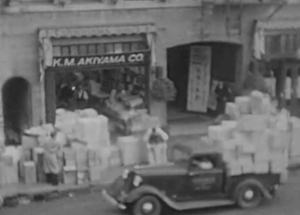 Her father was Issei pioneer, Masao Akiyama. “Issei” means the first generation immigrants who came to the US from Japan. Mr. Akiyama owned and operated “K.M. Akiyama Company,” a well-known store near the corner of San Pedro and First Streets. The Japanese American National Museum is home to the video archives of the Masao Akiyama Collection, with portions viewable online. Ohira can be seen as a young girl in this online footage. Her father took home movies before the war, and they are now preserved at the museum. Two snapshots from those movies are included in this article, courtesy of the museum. Click here for a link to the movie Masao Akiyama Collection, Archival, Discover Nikkei.
Her father was Issei pioneer, Masao Akiyama. “Issei” means the first generation immigrants who came to the US from Japan. Mr. Akiyama owned and operated “K.M. Akiyama Company,” a well-known store near the corner of San Pedro and First Streets. The Japanese American National Museum is home to the video archives of the Masao Akiyama Collection, with portions viewable online. Ohira can be seen as a young girl in this online footage. Her father took home movies before the war, and they are now preserved at the museum. Two snapshots from those movies are included in this article, courtesy of the museum. Click here for a link to the movie Masao Akiyama Collection, Archival, Discover Nikkei.
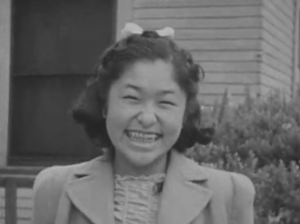 Ohira was just 12 years old when World War II broke out. After Executive Order 9066 was signed into law on February 19, 1942, over 120,000 Japanese Americans living on the West Coast were forced into ten major internment camps. Two-thirds were American citizens. That spring, Ohira and her family were forced onto buses in front of the old Union Church just down the street from their store. Eventually they ended up at the Poston, Arizona internment camp. Poston was divided into three smaller camps, and her family was sent to Poston One.
Ohira was just 12 years old when World War II broke out. After Executive Order 9066 was signed into law on February 19, 1942, over 120,000 Japanese Americans living on the West Coast were forced into ten major internment camps. Two-thirds were American citizens. That spring, Ohira and her family were forced onto buses in front of the old Union Church just down the street from their store. Eventually they ended up at the Poston, Arizona internment camp. Poston was divided into three smaller camps, and her family was sent to Poston One.
Asked why she started the campaign back in 2005, with friends Aiko O. King (88) and Fusa Takahashi (88), Ohira said, “We discussed the necessity to carry out the Go For Broke tradition.” “Go For Broke” was the motto of the 100th/442nd Regimental Combat Team, meaning, ‘Go for your goal with everything you’ve got!’
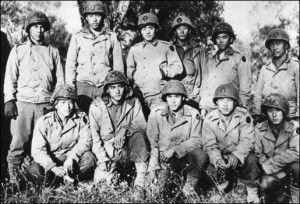 “It’s important to remember the veterans because it was a small battalion, and they worked hard to make a lasting impression,” Ohira pointed out. “Those guys were great because they were ostracized and still fought hard.”
“It’s important to remember the veterans because it was a small battalion, and they worked hard to make a lasting impression,” Ohira pointed out. “Those guys were great because they were ostracized and still fought hard.”
The loyalty of the Nisei was questioned by the US government after the bombing of Pearl Harbor by Japan. “Nisei” is the Japanese word to describe Americans born to parents from Japan. Nisei who enlisted in the US Army were placed in segregated units. Most were in the 100th/442nd, but many were interpreters, translators, and intelligence gatherers in the US Army’s Military Intelligence Service, as well. Ohira’s late husband, Ted, was a legendary 100th/442nd member of “H Company.”
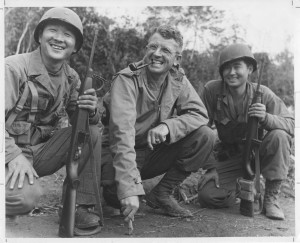 The Japanese Americans who served are one of the most acclaimed groups in US military history. The 100th/442nd would become the most decorated unit of the war with over 18,000 medals, 9000 plus Purple Hearts, and 21 Medals of Honor, all earned within just two years of service during the war. The MIS earned a Presidential Unit Citation, and were critical in winning the war against Japan. Their service is credited with shortening the war by two years. The MIS also served important post-war roles in the Allied Occupation of Japan. Both groups were awarded the Congressional Gold Medal in 2011.
The Japanese Americans who served are one of the most acclaimed groups in US military history. The 100th/442nd would become the most decorated unit of the war with over 18,000 medals, 9000 plus Purple Hearts, and 21 Medals of Honor, all earned within just two years of service during the war. The MIS earned a Presidential Unit Citation, and were critical in winning the war against Japan. Their service is credited with shortening the war by two years. The MIS also served important post-war roles in the Allied Occupation of Japan. Both groups were awarded the Congressional Gold Medal in 2011.
“Ted volunteered from Hawaii,” Ohira explained. “I think he volunteered because he lived in Honolulu and he saw the bombing of Pearl Harbor. He and his friends wanted to join the Army after that.” Ted Ohira was only 17 years old, and under the age requirement to serve in the Army at the time. But, the story goes, he wanted to serve so much that he tricked his parents to sign his enlistment papers just so he could join.
Ted Ohira was featured in the 1951 movie, “Go For Broke.” He can be seen playing the ukulele in the opening scene. “ Ted was good for the troops,” Ohira said. “He could sing and entertain them.” He would go on to serve in the military with great honor, awarded the Purple Heart and two Bronze Stars during the war. He fought in five major campaigns during the war, including in the famed Rescue of the Lost Battalion, when the 100th/442nd took heavy casualties to rescue 211 men from a Texas battalion that became surrounded by the Germans.
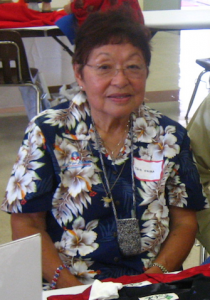 Ohira and her supporters are re-launching the stamp campaign this year to honor veterans like her late husband. The campaign is co-founded with Fusa Takahashi, who is also a widow of a Nisei veteran. Close friend Aiko O. King is also a founder. The campaign coalition includes family members and friends of the veterans, Emmy Award-winning film producer Jeff MacIntyre, and even actor George Takei. Many national organizations, including the Japanese American National Museum, Simon Wiesenthal Center – Museum of Tolerance, American Jewish Committee, and the Organization of Chinese Americans, have voiced past support for Ohira’s campaign. Prominent organizations are again encouraged to voice their renewed support and join in this coalition.
Ohira and her supporters are re-launching the stamp campaign this year to honor veterans like her late husband. The campaign is co-founded with Fusa Takahashi, who is also a widow of a Nisei veteran. Close friend Aiko O. King is also a founder. The campaign coalition includes family members and friends of the veterans, Emmy Award-winning film producer Jeff MacIntyre, and even actor George Takei. Many national organizations, including the Japanese American National Museum, Simon Wiesenthal Center – Museum of Tolerance, American Jewish Committee, and the Organization of Chinese Americans, have voiced past support for Ohira’s campaign. Prominent organizations are again encouraged to voice their renewed support and join in this coalition.
This month, the campaign is encouraging individuals to contact their members of Congress to sign a new Congressional letter of support which asks the Postmaster General to green light the stamp for these veterans. Another initiative this month will be an online White House petition to begin on February 19th, coinciding with the Day of Remembrance for the internment camps. The White House petition, if it can get 100,000 signers within 30 days, will get an official response from the President, or an official from his Administration. Though it is not a guarantee of a stamp, to get the President’s attention would be a major success. Signing the petition just requires the signer to be 13 years or older with a valid email address, which must be verified during the signing process.
The campaign hopes to gather enough support this year to make a push for a veterans stamp to be issued to coincide with the 75th commemoration of Executive Order 9066 and the internment next year, in 2017. The stamp would be the first of its kind to record such an important Asian American story on a stamp. Very few US stamps have ever even featured an Asian face. None has featured a historical Asian American event. Among the World War II series of stamps to commemorate 50 years since the war, in 1991-1995, Japanese Americans (and all Asian Americans) were left out of any depictions of Americans in uniform, despite their prominence in the war.
“I think the stamp is important because it’s not just a toy or something insignificant,” Ohira emphasized. “The stamp is a permanent thing. When people receive letters they do look at the stamp, right? I think it reaches people at many different levels.”
You can follow the campaign and help support their efforts on this website, on their Facebook page https://www.facebook.com/niseistamp, and on Twitter, https://twitter.com/StampOurStory.
View the historic movies from the Masao Akiyama Collection of the Japanese American National Museum, visit http://www.janm.org/collections/homemovies.
Watch for the White House petition online starting on February 19th through our website and on social media. Supporters are encouraged to “like” the campaign’s Facebook page, and to tell their friends and family, and organizations they belong to, to join in this nationwide movement.
